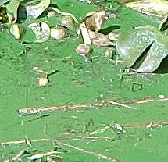|
WHAT ARE CYANOBACTERIA?
Cyanobacteria or "blue-green algae" are natural inhabitants of many inland waters, estuaries and the sea. In still waters, such as lakes, ponds, canals and reservoirs, they may multiply sufficiently in summer months to discolour the water, so that it appears green, blue-green or greenish brown. 
|
ARE THEY HARMFUL?
Recreational water users and livestock farmers, and anyone else coming into contact with infected water. HOW DO CYANOBACTERIA AFFECT ME? Cyanobacterial toxins may cause:
TO BE SAFE, AVOID CONTACT WITH THE SCUM AND THE WATER CLOSE TO IT. DO NOT EAT CONTAMINATED FISHFind out more: MINIMIZING THE RISK... at the Resource Quality Information Services Directorate. Last update 2015-08-13 11:57 |
|
[ RQIS Home Page ] |
|